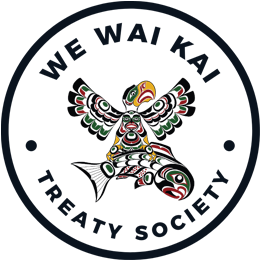As the We Wai Kai Nation, we are centred at Cape Mudge on Quadra Island and Quinsam on Vancouver Island. We are one part of a larger group of people, the Liǧʷiɫdax̌. All Liǧʷiɫdax̌ people share a common history, ancestor and language, Liq’wala. In our language, the word Liǧʷiɫdax̌ refers a large sea worm that cannot be easily killed, and if cut up, the pieces survive and swim away. Therefore, Liǧʷiɫdax̌ means “unkillable thing” (Curtis 1970 [1915]:308).
According to We Wai Kai oral history our creation occurred at Tikya in Topaze Harbour, east of Sayward, BC. Recorded by Phillip Drucker in 1953, Billy Assu tells the story of our first ancestor during the time of the flood:
The first man came down at Topaze Harbor, Wekai was his name and Tikya was the name of the place. There is a mountain there named Lakatisin and after a long time the flood was to come. Expecting the flood they [Wekai] made cedar rope that stretched from the top of the mountain to the salt water. Then he fastened two canoes together and the flood came and it lasted a long time. Wekai cut some of the people loose and these people landed elsewhere to start neighbouring Nations.
As the story says, following the flood, Wekai travelled the lands and through supernatural abilities, marriage and alliances he acquired many rights and privileges. Liǧʷiɫdax̌ people as a whole also began to spread out from Tikya and in more recent times, we exerted pressure on our neighbours to the south. Through war, we pushed southward into Discovery Passage, conquering the former territory of the Comox before the war ended (Boas 1966:41). This gave Liǧʷiɫdax̌ people complete control of the narrow passage ways along the east coast of Vancouver Island, including Seymour Narrows and Yaculta Rapids. We guarded these lands and waters closely and as guardians of this area, Liǧʷiɫdax̌ people were known to attack and plunder those who were passing through (Duff n.d.; Walbran 1971:455).
As our Liǧʷiɫdax̌ ancestors expanded out from Tikya they formed settlements at Port Neville, Loughborough Inlet, Salmon River (Xwesam), Phillips Arm (Matsayno), Kanish Bay, Surge Narrows (possibly Tatapowis meaning “by boulders going dry,” and Vancouver Bay (Saaiyouck) (Duff n.d.). At some point during this expansion the Liǧʷiɫdax̌ as a group began dividing, possibly in order to maintain a presence throughout the enlarged Liǧʷiɫdax̌ territory. The Wewaikum eventually moved to Campbell River, via Greene Point (Matlaten). The Walitsama people moved to the mouth of the Salmon River (Xwesam) (and later moved to Cape Mudge, Campbell River and Comox) and We Wai Kai settled around Discovery Passage and Cape Mudge.
Although We Wai Kai territory is large, we have only a few small parcels of land currently reserved to us. We have communities on two of those parcels: Cape Mudge (IR 10) and Quinsam (IR 12). Our other reserves are small and were mainly identified as reserves for fishing, which Canada never honoured. All together Canada set aside 665 ha of reserve land for our use but according to Canadian law, we do not own these lands. Today we have almost 1200 registered members and many more family members who are not able to register. We know our history and our history is marked on the land in the form of our old village sites, fish traps, clam gardens, culturally modified trees, etc. We continue to fish in Johnstone Strait, gather foods and medicines from our lands, take cedar for weaving, hunt elk and deer in our forests, trap on our lands and many other things that continue to hold us to our lands and waters. We continue to protect our heritage sites and use our water, lands and resources to support our strong big house culture. We are strongly connected to our lands and waters and we continue to act as stewards over them as our ancestors did and as we were taught by our Elders.
Sources:
Boas, Franz
1966 Kwakiutl Ethnography. Chicago: University of Chicago Press.
Curtis, Edward S.
1970 [1915] The North American Indian. Volume 10. Norwood, Mass.: Plimpton Press.
Drucker, Philip
1953 Fieldnotes of Interviews with Ed Whonnock, Charles Nowell and Billy Assu. Archives of the Bureau of American Ethnology Smithsonian Institution, 4516:2, Vol. II.
Duff, Wilson
n.d. Lekwiltok in the Wilson Duff Collection at the Royal BC Museum Library, File 91.
Walbran, John T.
1971 British Columbia Coast Names, 1592-1906 : To Which are Added a Few Names in Adjacent United States Territory : Their Origin and History: with map and illustrations.
Vancouver: J.J. Douglas.
